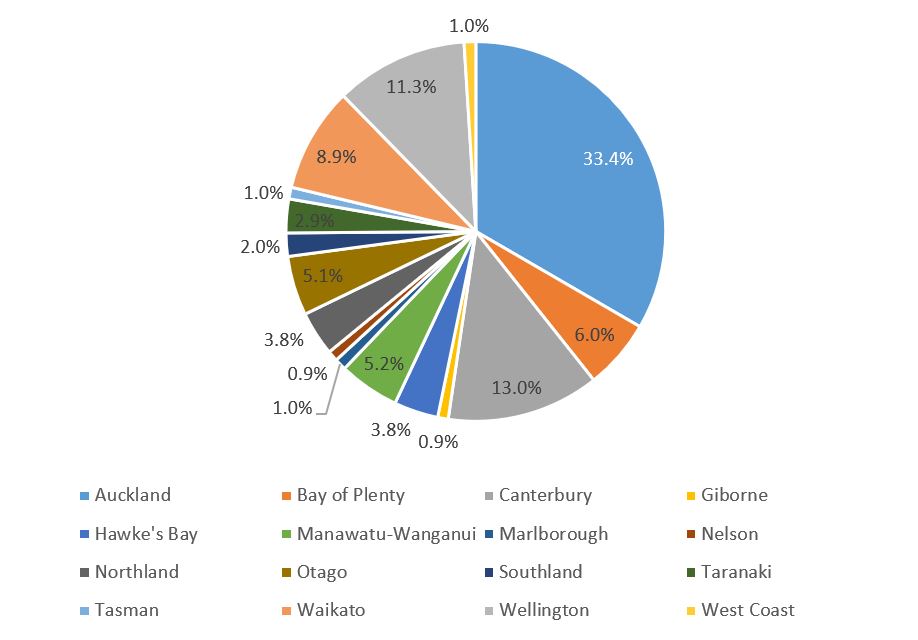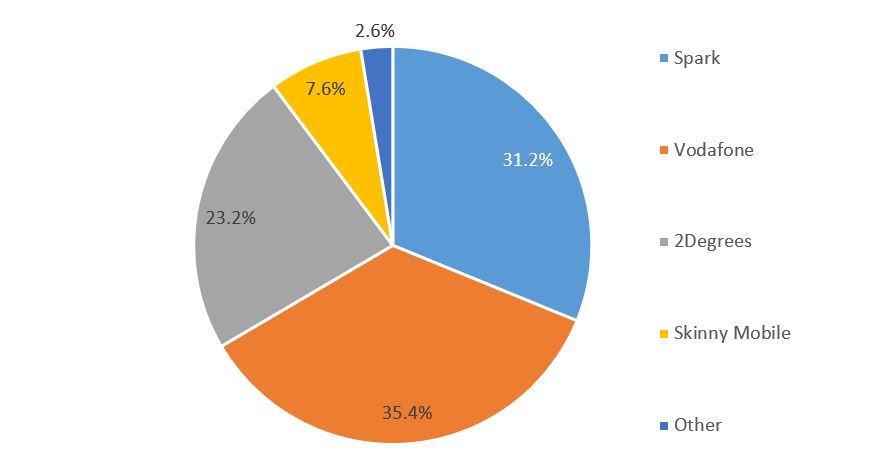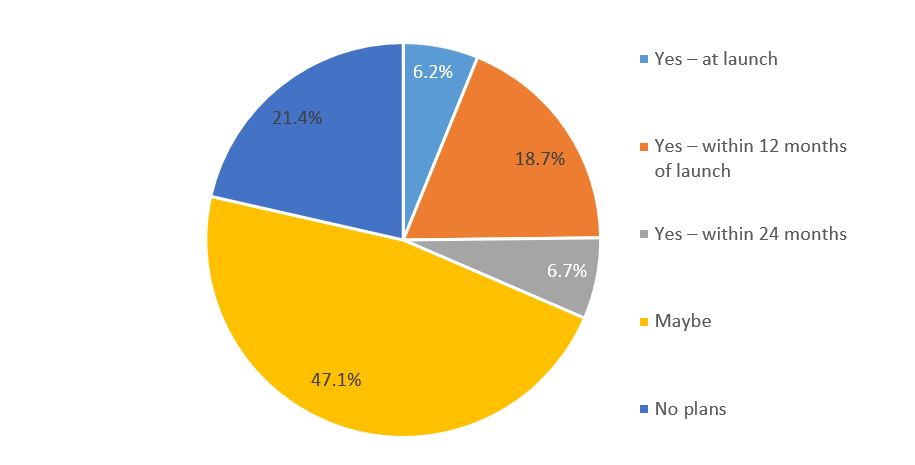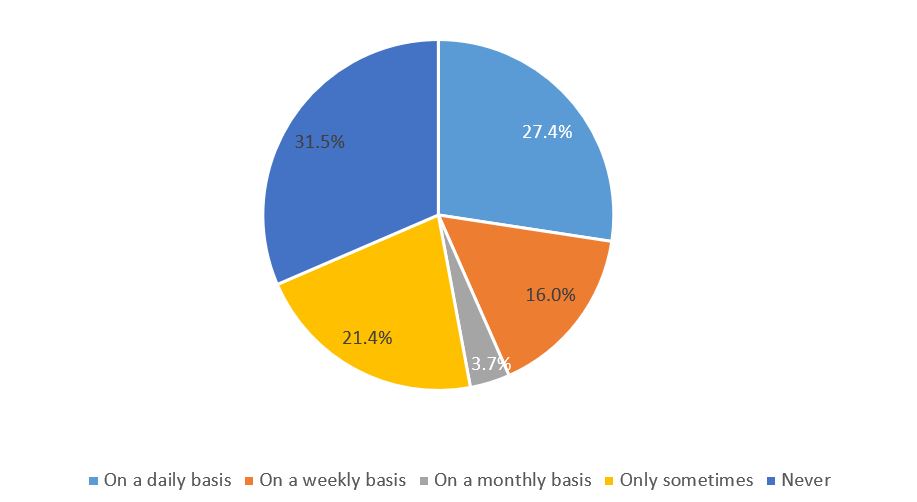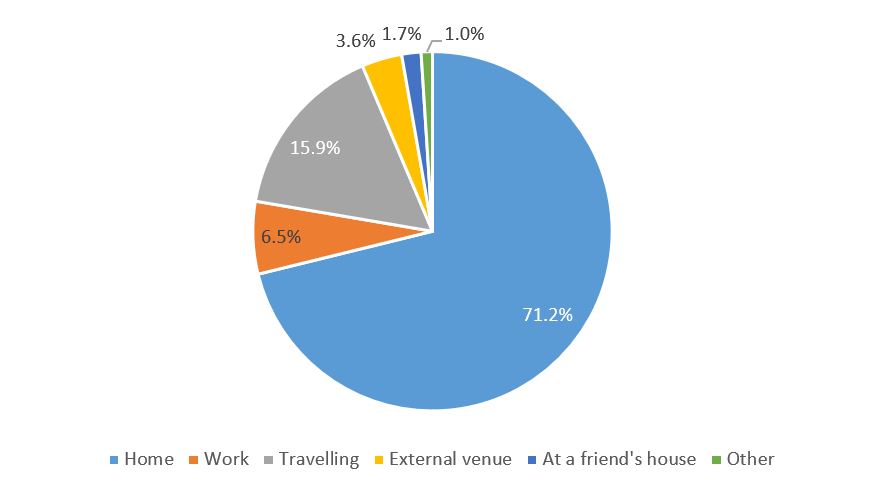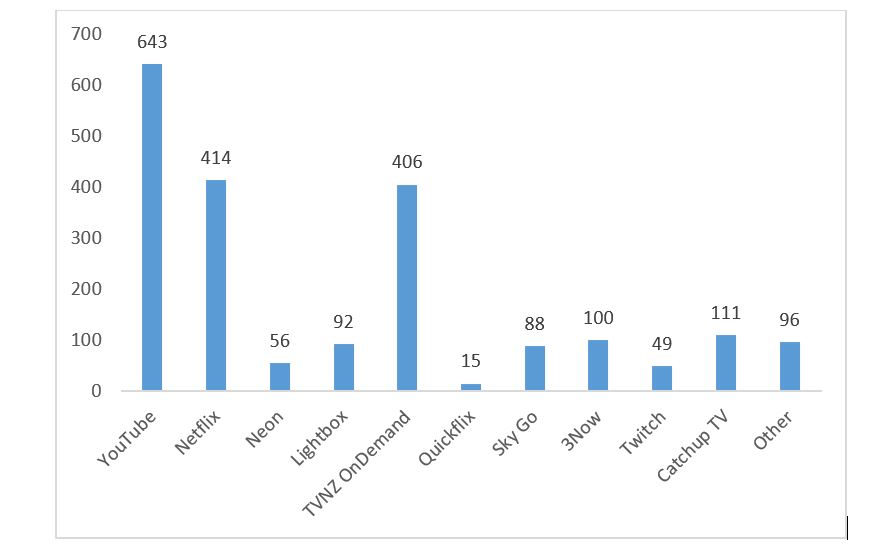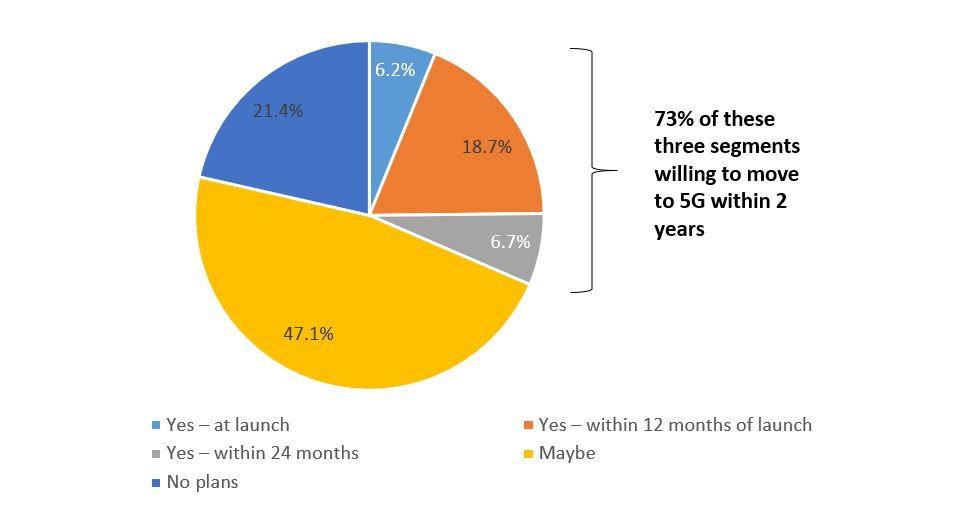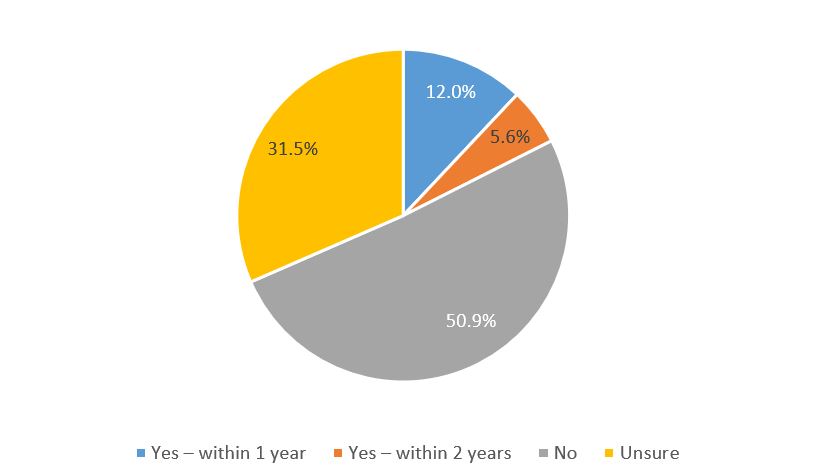Abstract
This paper summarizes results from a survey of the New Zealand mobile market by Venture Insights in October 2018. The survey had over 1,000 respondents, all of whom were responsible for making their mobile purchasing decisions, with a representative spread across New Zealand, all adult age groups, and customers from the three major mobile service providers. The survey identified a strong consumer interest in and awareness of 5G, with 31% of respondents willing to consider a move to 5G within two years of launch. Mobile video will be a strong driver, with 69% of respondents having viewed video on their mobile and, again, a willingness to move to 5G within two years. Fixed wireless broadband service was also strongly supported, with 18% of those with a household fixed broadband service indicating a possible transition within two years to a 5G fixed wireless service. However, the Ultra-Fast Broadband fixed service is likely to be a strong competitor to fixed wireless broadband.
Introduction
In October 2018, Venture Insights conducted a market survey in order to better understand consumer interest in the evolving New Zealand mobile market and the early adoption of 5G services and platforms. This paper, after some background on the respondents, focusses on four key aspects of the survey:
- Consumer 5G awareness and competition for the early adopter market;
- Consumer usage of mobile video and streaming services;
- 5G use case for mobile and telco media bundling;
- 5G use case for fixed wireless broadband.
New Zealand Consumer Survey Background
The Venture Insights New Zealand mobile consumer survey was conducted in October 2018 and included 1,007 completed responses spread across New Zealand â see Figure 1.
Figure 1. New Zealand Survey - Geographic Spread
(Source: Venture Insights NZ Consumer Mobile Survey, October 2018, n=1,007)
Figure 2. New Zealand Survey â Age Bands
(Source: Venture Insights NZ Consumer Mobile Survey, October 2018, n=1,007)
The survey included a gating question to ensure that all respondents were responsible for purchasing the service. In addition to regional coverage, the survey also represented a fair spread of age and income bands â see Figure 2.
When asked which mobile operator was their primary provider (Figure 3), Vodafone recorded 35.4%, Spark 31.2% and 2Degrees 23.2%. Given the competition for market share in New Zealand, we believe the 5G launch phase will be highly competitive as the mobile operators seek to attract the early 5G adopter market and push forward with their 5G network rollouts.
Figure 3. New Zealand Survey â Primary Mobile Account of Respondents
(Source: Venture Insights NZ Consumer Mobile Survey, October 2018, n=1,007)
Consumer Interest in 5G
Similar to Venture Insightâs Australian mobile survey (Pugh, 2019), the New Zealand survey tested consumer interest in 5G and respondentsâ willingness to take up a 5G service.
The survey showed that 30% of respondents were aware of plans to deploy 5G networks, with the majority of these being existing Vodafone and Spark customers. This suggests that recent 5G trials and press coverage â see, for example, Sparkâs 5G briefing paper (Spark, 2018a) â are getting the attention of consumers.
However, unlike the Australian telcos â who have flagged 2019 launch timeframes, the New Zealand market is still discussing launch timeframes of 2020. At the time of the survey (October 2018), there was uncertainty about the New Zealand spectrum auction planning process, with the NZ Government then yet to respond to 5G spectrum planning submissions, which had closed on 30 April 2018. Subsequently, in February 2019, the Minister has announced plans (Faafoi, 2019) to auction spectrum in the 3.5 GHz band âearly in 2020â, with full rights to the spectrum âfrom November 2022â. As such, the mobile operators are still waiting for greater clarity on when additional 5G spectrum will be available and in which bands.
In terms of willingness to upgrade to 5G (Figure 4), we found that 6% of all respondents would consider migrating at launch, with a further 25% willing to migrate within 24 months. Interestingly, the majority of these early adopters were existing Vodafone customers.
Figure 4. New Zealand Survey â Consumer Willingness to Move to 5G
(Source: Venture Insights NZ Consumer Mobile Survey, October 2018, n=1,007)
The survey also showed that 11% of respondents would be willing to pay more for a 5G service, indicating demand for superior networks could be matched by innovative pricing for some segments of the market. Similar results were found for willingness to pay more for a 5G handset.
Given the strong growth in smartphone usage across a wide range of applications, the survey results confirm our view that consumers care about technology upgrades and are willing to shift (and in some cases) pay more to gain an improved mobile experience.
Mobile Video Usage
Mobile video usage was strong, with 69% of respondents indicating they had viewed video on their mobile and 43% reporting that they watched video streaming services regularly (i.e. on either a daily or weekly basis). In addition, 73% of respondents who watched video on their mobile indicated that they watched more video content now than a year ago.
Time-of-day viewing was reasonably spread, with the highest viewing times being late afternoon and evening between 5 pm and 8 pm, reflecting a mix of travelling from work and evening viewing. Indeed, the majority (78%) of respondents mainly watched video streaming content at home (71%) or when travelling (7%). The relative high percentage of âat homeâ viewing was also supported by 76% of respondents reporting watching mobile video content only when connected to a Wi-Fi connection.
Figure 5. Mobile Video Viewing
(Source: Venture Insights NZ Consumer Mobile Survey, October 2018, n=1,007)
Of the 69% of respondents who watched video content on their mobile, the top three most watched streaming services were YouTube, Netflix and TVNZ OnDemand
Figure 6. Main Locations for Viewing Video Content on Mobile
(Source: Venture Insights NZ Consumer Mobile Survey, October 2018, n=1,007)
When asked to rate the factors that limited video viewing, the top three limiting factors were mobile data limits (24%), the screen being too small (30%) and battery life (17%). We note that all three of these factors are trending upwards, with consistently larger mobile data limits every year and mobile phone screen and battery sizes typically increasing with each new generation.
Figure 7. Video Streaming Services Watched the Most: top 3 video services per respondent
(Source: Venture Insights NZ Consumer Mobile Survey, October 2018, n=1,007)
5G Video Use Case and Telco Media Bundling
Of the respondents who indicated they were willing to move to 5G within 2 years, 73% watched video content on their mobile either daily, weekly or monthly. This suggests that video viewing will be a strong use case for consumer 5G â especially when marketed with the benefits of 5G technology such as faster download speeds and lower latency.
Figure 8. Consumer Willingness to Move to 5G
(Source: Venture Insights NZ Consumer Mobile Survey, October 2018, n=1,007)
The NZ consumer mobile survey also asked respondents to rate six factors when purchasing their next mobile phone service. Unsurprisingly price rated at number one, with 90% of respondents rating this as important/very important, closely followed by network performance/speed rated at 81%. However, the importance of bundled media with mobile plans was rated at just 24%. Whilst this indicates there is still a healthy segment of the NZ consumer market interested in bundled media, operators should clearly emphasise network performance in their 5G video use case to maximise uptake.
Table 1. Importance of Mobile Factors at Respondentâs Next Mobile Service Purchase
|
Mobile Factor |
Consumer Ranking |
|
Price |
90% |
|
Network Performance/Speed |
81% |
|
Data Allowance |
68% |
|
Regional Network Coverage |
79% |
|
Handset included |
30% |
|
Bundled media/video services |
24% |
Source: Venture Insights NZ Consumer Mobile Survey, October 2018, n=1,007,
Ranking = Important/Very Important
The media-bundling strategies of the major New Zealand telcos are summarized in Table 2.
Table 2. New Zealand Major Telco Media Strategies
|
|
Mixed Strategy:
|
Bundling Strategy:
|
|
|
Mixed Strategy:
|
Bundling Strategy:
|
|
|
Partnership Strategy:
|
Bundling Strategy:
|
Source: Venture Insights
5G Fixed Wireless Broadband Use Case
Another strong use case for 5G is fixed wireless broadband. In Australia we have seen announcements from both Optus and Telstra with plans to launch a fixed wireless 5G service (in metro areas). Optus reported three live sites at 31 January 2019, with plans for 1,200 5G sites by March 2020 (Optus, 2019). Telstra has reported that it has rolled out â200 5G-capable base stations across Australia by the end of 2018â (Turner, 2019). From late May 2019, Telstra has been offering an HTC 5G Hub for home broadband (Duckett, 2019).
When we asked the New Zealand survey respondents with fixed broadband household services (such as fibre or copper) if they would consider switching to a wireless broadband service, 18% indicated they would consider switching within the next two years. Interestingly, this is a lower result when compared with our Australian broadband survey (Pugh, 2019) â which indicated 30% of existing fixed broadband respondents would consider migrating within the next 2 years. We believe the larger result in Australia was attributable to consumer dissatisfaction with the Australian NBN (where some respondents indicated they had concerns with the NBN).
Figure 9. Fixed Broadband Respondents Considering Shift to Wireless Broadband
(Source: Venture Insights NZ Consumer Mobile Survey, October 2018, n=649)
Over the last two years, the New Zealand mobile market has seen the launch of several wireless broadband services, first by Spark-owned Skinny Mobile, which was followed by Sparkâs own wireless broadband service in April 2016. Vodafone launched its wireless broadband service in December 2016.
Spark has been marketing its wireless broadband as an upgrade for 1) areas that are serviced by old copper lines, 2) areas that may not receive the UFB (Ultra-Fast Broadband fixed-line service) and 3) users with low to moderate data usage. It has been fairly aggressive in its approach and has signed up 116,000 customers by August 2018 â which Spark claims has resulted in operating cost savings and a 6.5% uplift in broadband gross margin (Spark, 2018b).
Clearly, wireless broadband represents a good option for NZ mobile operators to bypass the UFB (for some customer segments) and protect their margins. With the upcoming launch of 5G, there is clear scope for the 5G wireless broadband plans to improve and place further pressure on Chorus. However, the UFB is a strong competitor, with unlimited 100 Mbps plans and 1 Gbps plans already in service, trial 10 Gbps services announced (Chorus, 2019a), and over 529,000 fibre connections in place at 31 December 2018 (Chorus, 2019b). As such, although the consumer survey shows there is demand for wireless broadband services, actual take-up may be lower than the survey results, given the strong positioning of the UFB services and the relative delay in launching 5G services.
Conclusion
Venture Insightsâ New Zealand mobile survey has indicated strong consumer interest in 5G, with 30% of respondents aware of operator plans to deploy 5G networks and 31% willing to migrate to 5G within two years. These results are lower than those from the corresponding Australian survey, which we believe reflects the NZ operatorsâ reluctance to push 5G rollouts while uncertainties remain about when additional 5G spectrum will be available and in which bands.
The survey indicated that 11% of NZ respondents would be willing to pay more for a 5G service, which suggests that the demand for superior networks could be matched by innovative pricing for some segments. Video will be a strong consumer use case for 5G: 43% of respondents regularly view video on their mobile, with close to 50% of those users wanting to move to 5G within two years.
In the NZ survey, 18% of fixed broadband respondents indicated that they would consider switching to a fixed wireless service within two years. This could build on Sparkâs existing push for fixed wireless services, especially when 5G services are launched. The result on fixed-wireless migration is lower than in the equivalent Australian survey, but the larger Australian result is probably attributable to consumer dissatisfaction with the Australian NBN. Migration to 5G fixed wireless services may also be less likely, due to the strong position of the UFB in New Zealand.
Acknowledgements
The author would like to thank Dr Leith Campbell (Honorary Fellow, Melbourne School of Engineering) for his advice on this article.
References
Chorus. (2019a). Supercharging New Zealandâs broadband with a 10Gbps trial. Broadband Basics, 4 February. Available at https://www.chorus.co.nz/blog/supercharging-new-zealands-broadband-10gbps-trial
Chorus. (2019b). Half year result. Media Release, 25 February. Available at https://company.âchorus.co.nz/half-year-result
Duckett, C. (2019). Telstra releases HTC 5G Hub online. ZDNet, 22 May. Available at https://www.zdnet.com/article/telstra-releases-htc-5g-hub-online/
Faafoi, K. (2019). 5G on track for 2020: 3.5 GHz spectrum the first available. Ministerial press release, 28 February. Available at https://www.beehive.govt.nz/release/5g-track-2020-35-ghz-spectrum-first-available
Optus. (2019). Optus 5G Whiz: Optus announces plans for 1,200 5G sites in first wave, $70 per month unlimited 5G broadband plans, live 5G sites and the chance to be amongst the first Australians to experience 5G. Optus Media Release, 31 January. Available at https://www.optus.com.au/about/media-centre/media-releases/2019/01/Optus-5G-Whiz
Pugh, N. (2019). The Wireless Threat to Fixed Broadband Services. Journal of TeleÂcommunications and the Digital Economy, 7(1), 7-19. doi:10.18080/jtde.v7n1.178
Spark. (2018a). 5G: The evolution towards a revolution. Spark NZ Briefing Paper, August. Available at https://www.sparknz.co.nz/content/dam/SparkNZ/pdf-documents/5Gâ%20Briefing%20document.pdf
Spark. (2018b). Spark New Zealand FY18 results show strong performance in growth areas while transforming business for the future. Spark NZ Investor Paper, August. Available at https://www.sparknz.co.nz/news/Spark_FY18_results/
Turner, A. (2019). Telstra set to start offering 5G smartphones in the first half of 2019. Sydney Morning Herald, 10 January. Available at https://www.smh.com.au/technologyâ/telstra-set-to-start-offering-5g-smartphones-in-the-first-half-of-2019-20190110-p50qm6.html

